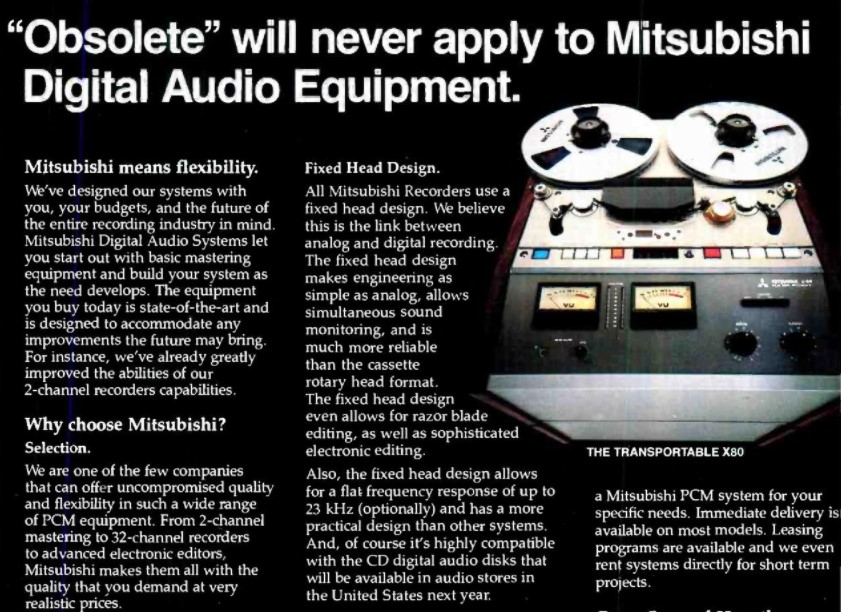Thomas Bårdsen is Audio Production Manager at the National Library of Norway
I guess the first digital thing that entered my house growing up, was music. A shiny disc of digital information, read out via laser technology. So futuristic, at the time I think it even changed my hairstyles in a more “pointy” direction. Those discs were just an end product of a whole new direction in music production. The whole music production chain aimed digital. The discs were graded and stamped as if they were jewelry. DDD meaning digital technology were used from start to finish. Music productions have in some ways been born digital for over 35 years. It has also left some strange digital collections behind. In the very early eighties, going digital was a risky and costly piece of business. The previous analog era in music technology, had at least tried to be compatible. The new approach from the industry was that of proprietary systems. Legendary record producer Richard Burgess called the approach of the early digital audio formats a winner takes all play, were larger companies hoped on maximizing profits by squeezing out all competition.
When digital reel to reel recorders first appeared, competing giant companies like 3M, Mitsubishi and Sony each went on the market with their own systems. Tapes couldn`t be swapped between studios anymore unless they used the same equipment. The specific tape was locked to a specific family of machines. If that wasn`t enough, each of these technologies were ever changing. The most common of these systems in Norway was the Mitsubishi formats. The first stereo machine was the Mitsubishi X-80, appearing in Norway as early as 1981. For servicing and upgrades, it had to be shipped back to the factory in Japan. Certain upgrades meaning older tapes would no longer play. Only 200 machines were ever built, and Mitsubishi never got round and made a proper service manual. The next line of stereo machines was already on its way with the X-86. Released in 1986, it wasn`t even compatible with their own previous model. Their last machine, the X-86HS came a few years later in 1988. It too introduced a whole new format only compatible with that specific model. The Mitsubishi multitrack machines were at least compatible with each other, though probably the most unreliable machines I have ever used. Even in their prime years, servicing was quite a challenge. A studio owner in Trondheim still recalls the name of the service engineer swapping a recording head on their machine. They flew the guy all the way from Japan to Trondheim and back.
In 1992 Mitsubishi withdrew from the music industry all together. Their digital reel to reel machines were still in use though all the way to the end of the millennia alongside their Sony DASH competitors, leaving over 1600 different digital reel to reel tapes in 15 different specific configurations in our vaults.
This year we have completed transferring all of them to preservation file sets. With relief we pushed the clunky machines into storage. One of them had been on fire twice. The process had certainly had its challenges. The first one being when we realized not only did Sony and Mitsubishi have their own tape formats. The clever engineers even made their own proprietary standards for transferring digital signals out of the machines. Mitsubishi made their MELCO interfaces, and Sony their SDIF2. Luckily a format converter box were made in the late 90`s so the digital signal could be translated into something more useful. The box didn’t actually work for all configurations though. Especially the common 32 track Mitsubishi formats. A few weeks and phone calls later, we found an expert on the machines, that once had made this work. The cables had to be wired in a different way than stated in any documentation. Apart from that, he added, he wasn`t entirely sure there may also be a hint of black magic needed. The digital connection working on and off for periods. We figured out the magic bit after a while too. We didn't need to dance or chant, but find a hidden feature deep in the menus of the converter box. There we could adjust if the signal should be read from the ascending or the descending curve of the digital clock stream. A challenging task as the box had no display. Everything was set through holding and pressing a combination of buttons and watching small lights give away cryptic flashes.
The oldest Mitsubishi X-80 machines didn`t work with no converter though, and we long thought our only option would be to re-digitize from the analog outputs. That was until our film department bought some new equipment from California. The guy installing the machines happened to have started his career assembling and servicing Mitsubishi digital machines. He had kept a bunch of documents in LA. From them, we found a procedure for migrating from the X-80 to the later X-86HS digitally. By following this procedure, and tricking the X-86HS we could use the latter as a format converter and finally transfer those last digital bits of the tapes. Another challenge came in the form of bit split tapes. In the late 90`s one could trick 16 bit recorder into recording 24 bit audio files using special hardware. Many companies of these boxes had their own proprietary format of course. No description of the specific system was to be found on the box. Luckily we got hold of the audio engineer involved. He had kept the hardware and documentation, and sent them all to us.

Db magazine November 1981: February 1982 Mitsubishi started the process rebuilding their machines to a new standard. All tapes recorded on the machine in the add were in fact obsolete just a few months later.
So who won the digital reel to reel race? I guess nobody, but there were plenty of losers and quite a bit of lessons to be learned from the collections it left behind. I guess the first one being that it is best to do strange data conversions when there are still people to call or stumble upon.

Comments